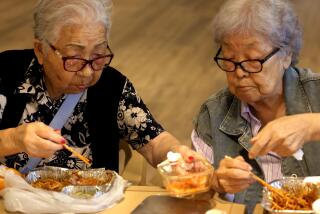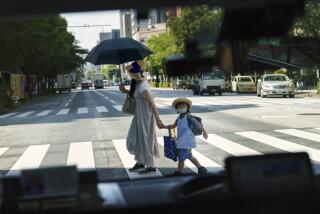Land of Rising Sun Faces Twilight-Years ‘Boom’
TOKYO — Shizue Sugimura is training for Japan’s mega-industry of the future: the elderly.
The college senior, who just landed a job in a sparkling new nursing home, spent a recent afternoon learning how to spoon-feed rice to the bedridden, give them sips of tea and brush their teeth.
“This society is aging faster than any other country in the world, so there is quite a lot of demand for this type of industry,” said Sugimura, 22.
With the world’s longest average life spans and one of its lowest birthrates, Japan is expected to displace Sweden by 2005 as home to the planet’s oldest population.
The trend is already straining pension and health care systems, and Japan’s economy will increasingly feel the pinch of caring for more elderly with fewer workers.
The aging process has also brought the Japanese face to face with some thorny social questions, such as the clash between women’s work and family roles and the changing obligations of children to their aging parents.
To many, the changes signal a risky venture into uncharted waters.
People older than 65 already make up 15% of the population, and the ratio is expected to hit 20% by 2005 and 33% by 2050. They are living longer, too--females born in 1996 are projected to live an average of more than 86 years and the males are expected to average just over 80, both world highs.
“In the early 21st century, the extent of Japan’s full-blown elderly society will be something that no other country in the world has ever experienced,” the government said in a report this year.
But for Sugimura and others like her, aging Japan means opportunity.
“I’ve done volunteer work visiting nursing homes since high school, and I enjoyed it,” said Sugimura, who starts her new job in April. “For Japan, this work is going to expand.”
The company training her, Benesse Corp., is banking on that. A publisher specializing in correspondence courses, Benesse is one of a growing number of corporations branching into the elder-care business.
The company has graduated 2,500 people in a four-year-old “home helper” training course, and the number of graduates this year is expected to double over last year. The company also runs its own home helper service for people caring for elderly relatives at home.
At a recent session at the company’s offices in western Tokyo, about 45 students--half of them training to take care of their own aging parents--scooped spoonfuls of rice and fish into each other’s mouths and gingerly brushed each other’s teeth as Chopin played in the background.
“Years ago, there was no concept of this as a service industry,” said instructor Hiroe Nagao, a nurse. “But now regular businesses like Benesse are entering the field.”
Encouraging companies to get into the elderly business is part of a government plan for a huge increase--in some cases a doubling--in services and facilities for the over-65 population by 1999. Further increases are expected to follow.
One way the government expects this to work without bankrupting its budget is shifting costs to the consumer. Officials say the social welfare system set up in the 1950s should be updated to reflect the current older generation’s greater wealth.
“Some of them still get paid or have assets that they can use to live out the rest of their lives,” said Naoki Miyamoto, an official in the policy planning division of the Health and Welfare Ministry.
The process has already begun. Health care for the elderly used to be free, but beginning in 1984 the elderly had to pay 10% of their health costs. That was recently raised to 20%. So far, the government has not faced any widespread public opposition.
Another major factor the Japanese are counting on to smooth the transition is people like Kiyoko Hashimoto. She’s training at Benesse not for a job, but for what she figures is her fate: taking care of aging relatives.
“My parents are getting old, and in the spring my father got sick,” said Hashimoto, 41, whose father is in his early 70s--and whose grandfather is 102. “That’s when I thought that maybe, in the future, it would be helpful for me to learn about nursing.”
Japan has few nursing homes, and most people assume their children will care for them when they get old. More than 50% of the elderly live with their middle-aged children or other relatives, and most of those who live on their own are less than an hour’s drive from their children.
But some say government plans are unrealistic in expecting families will assume the growing burden of caring for Japan’s older generations.
“The government still thinks that co-residence is Japan’s latent asset, but it’s not true,” said Naohiro Ogawa, an expert on aging at Nihon University. “Family structure sets Japan apart from the West, but . . . the value shifts, the generational gaps in terms of values, are quite serious.”
At the core of the debate are Japan’s primary caregivers: women. Housewives are typically expected to rear children with minimal help from anyone else, then spend their middle age taking care of their husbands’ parents.
But women are increasingly turning to careers, resulting in the decreasing fertility rate that has helped speed the aging of Japan. Women average only 1.42 children, down from a high of 5 in the late 1940s.
Critics like Ogawa say such trends make it increasingly unlikely that families will be able-- or willing--to take up the additional burdens of the elderly population.
Many Japanese, however, still take for granted that they will have to tend to their older relatives.
Hashimoto said that with her parents living hours away in distant Aomori in northern Japan, she and her siblings will have to rotate shifts living in with her parents if they get sick.
But even in Hashimoto’s family, generational shifts are evident. She doesn’t expect the same from her own four kids.
“All my children are independent in a kind of selfish way,” she said. “If they want to do it, that’s fine, but it’s not like they should have to or should be forced.”
More to Read
Inside the business of entertainment
The Wide Shot brings you news, analysis and insights on everything from streaming wars to production — and what it all means for the future.
You may occasionally receive promotional content from the Los Angeles Times.










